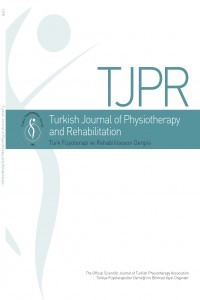Gebelik sürecinde zaman mesafe parametreleri ve plantar basınç dağılımı
Gebelik, Gebelik trimesterleri, Yürüme
Time-distance parameters and plantar pressure distribution of gait during pregnancy period
Pregnancy, Pregnancy trimesters, Gait,
___
- Foti T, Davids J, Bagley A. A biomechanical analysis of gait during pregnancy. J Bone Joint Surg Am. 2000;82:625-632.
- Sade A, Algun C, Otman S. M. Rektus abdominis, m. oblikus internus, eksternus ve sırt ekstansörlerinin kas testi ile değerlendirilerek, doğum yapmış ve yapmamış kadınlarda, çeşitli yaş gruplarında karşılaştırılması. Fizyoter Rehabil. 1984;4:481-489.
- Kara F, Akarcalı İ, Akbayrak T, et al. Gebelikte diastatis recti abdominis insidansı. Fizyoter Rehabil. 1996;8:24-29.
- Fries E, Hellebrandt F. The influence of pregnancy on the location of the center of gravity, postural stability, and body alignment. Am J Obstet Gynecol. 1943;46:374-380.
- Marnach M, Ramin K, Ramsey P, et al. Characterization of the relationship between joint laxity and maternal hormones in pregnancy. Obstet Gynecol. 2003;101:331-335.
- Stephenson R, O’Connor L. Obstetric and gynecologic care in physical therapy. Second edition. 2000; Slack Inc, New Jersey, USA
- Oliveira LF, Vieira TMM, Macedo AR, et al. Postural sway changes during pregnancy: a descriptive study using stabilometry. Eur J Obstet Gynecol Reprod Biol. 2009;147:25-28.
- Jang J, Hsiao K T, Hsiao-Wecksler E. Balance (perceived and actual) and preferred stance width during pregnancy. Clin Biomech (Bristol, Avon). 2008;23:468-476. Dynamic postural stability during advancing pregnancy. J Biomech. 2010;26;43:2434-2439.
- Franklin M, Conner-Kerr T. An analysis of posture and back pain in the first and third trimesters of pregnancy. J Orthop Sports Phys Ther.1998;28:133- 138.
- Nyska M, Sofer D, Porat A, et al. Plantar foot pressures in pregnant women. Isr J Med Sci. 1997;33:139-146.
- Lymbery JK, Gilleard W. The stance phase of walking during late pregnancy: temporospatial and ground reaction force variables. J Am Podiatr Med Assoc. 2005;95:247-253.
- Albino MA, Moccellin AS, Firmento Bda S, et al. Gait force propulsion modifications during pregnancy: effects of changes in feet's dimensions. Rev Bras Ginecol Obstet. 2011;33:164-169. reaction forces during gait in pregnant fallers and non-fallers. Gait Posture. 2011;34:524-528.
- Wu W, Meijer OG, Lamoth CJ, et al. Gait coordination in pregnancy: transverse pelvic and thoracic rotations and their relative phase. Clin Biomech (Bristol, Avon). 2004;19:480-488.
- Bird AR, Menz HB, Hyde CC. The effect of pregnancy on footprint parameters. A prospective investigation. J Am Podiatr Med Assoc. 1999;89:405- 409.
- Cote K, Brunet M, Gansneder B, et al. Effects of pronated and supinated foot postures on static and dynamic postural stability. J Athl Train. 2005;40:41- 46.
- Block RA, Hess LA, Timpano EV, et al. Physiologic changes in the foot during pregnancy. J Am Podiatr Med Assoc. 1985;75:297-299.
- Gaymer C, Whalley H, Achten J, et al. Midfoot plantar pressure significantly increases during late gestation. Foot (Edinb). 2009;19:114-116.
- Karadag SE, Unlu OF, Basgul A. Plantar pressure and foot pain in the last trimester of pregnancy. Foot Ankle Int. 2010;31:153-157.
- Ribeiro AP, Trombini-Souza F, de Camargo Neves Sacco I, et al. Changes in the plantar pressure distribution during gait throughout gestation. J Am Podiatr Med Assoc. 2011;101:415-423.
- Dunning K, LeMasters G, Levin L, et al. Falls in workers during pregnancy: risk factors, job hazards, and high risk occupations. Am J Ind Med. 2003;44:664-672.
- Butler E, Colon I, Druzin M, et al. Postural equilibrium during pregnancy: decreased stability with an increased reliance on visual cues. Am J Obstet Gynecol. 2006;195:1104-1108.
- Wu WH, Meijer OG, Bruijn SM, et al. Gait in Pregnancy-related Pelvic girdle Pain: amplitudes, timing, and coordination of horizontal trunk rotations. Eur Spine J. 2008;17:1160-1169.
- Wu W, Meijer OG, Jutte PC, et al. Gait in patients with pregnancy-related pain in the pelvis: an emphasis on the coordination of transverse pelvic and thoracic rotations. Clin Biomech (Bristol, Avon). 2002;17:678-686.
- ISSN: 2651-4451
- Başlangıç: 1974
- Yayıncı: Türkiye Fizyoterapistler Derneği
Yaşlılarda fiziksel aktivite ile uyku kalitesi arasındaki ilişki
Farklı servikal bölge izometrik egzersiz tiplerinin karşılaştırılması
Diz altı amputelerde farklı postoperatif ödem kontrol yöntemlerinin etkinliğinin karşılaştırılması
Gebelik sürecinde zaman mesafe parametreleri ve plantar basınç dağılımı
Baş dönmesi şikayeti olan bireylerde baş dönmesi süreğenliği ile depresyon ilişkisinin incelenmesi
Ampute milli futbol takımının beslenme durumu ve antropometrik ölçümlerinin değerlendirilmesi
